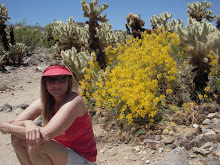 JTNP December 2007, Twentynine Palms Visitors Center
JTNP December 2007, Twentynine Palms Visitors CenterOur family spent the 2007 Christmas holiday at my in-laws in 29 Palms. My husband and I journeyed into nearby Joshua Tree National Park for two days of exploring and hiking, scrambling on boulders, snapping photos. The weather was nippy. At night, lows were in the 20's. Daytime temperatures in the park rose to about 40 degrees. When the wind kicked up, the chill air cut through me. If a storm blew in, there would have been snow.
The skies were an unbelievable blue, the clearest days I've seen in the desert. William and I drove up to Keys View, the highest point in the park at an elevation of 5,400 feet. We could see Palm Springs in the distance, Palm Desert and Indio. Of special beauty was the Salton Sea, usually buried under clouds or haze, Signal Mountain and Mexico beyond. Standing at Keys View, I envisioned being carried away in a strong gust like the red hawks soaring nearby, their wings gracefully outstretched.

view of the Salton Sea from Keys View
JTNP April 2005, cactus flower
 April 2005, Old Dale mining district
April 2005, Old Dale mining district Santa at a campsite in Hidden Valley
Santa at a campsite in Hidden ValleyWalking in the park this week, I pondered why I'm so in love with the desert around Joshua Tree. Words that came to me are:
Random: Giant boulders found at the park look like they were scattered randomly. In reality they were pushed up over eons from the earth's core. Walking around the desert, you'll come across things that are truly random--a crossword puzzle speared on a cactus, a piece of tortoiseshell, a set of rusted box springs, an old book. The park is cleaned and maintained more than other spots in the open desert, so you'll find less trash there. The sense of randomness offers a spirit of adventure, never knowing what you might find, what might be over the next ridge or turn in the road.
Dramatic: The desert is nothing if not dramatic. The white sun, blue sky, black mountains, the bursts of life and color found at your feet--an animal or insect, a flower or shadow. In the desert I feel as if I'm standing face to face with God.
Random: Giant boulders found at the park look like they were scattered randomly. In reality they were pushed up over eons from the earth's core. Walking around the desert, you'll come across things that are truly random--a crossword puzzle speared on a cactus, a piece of tortoiseshell, a set of rusted box springs, an old book. The park is cleaned and maintained more than other spots in the open desert, so you'll find less trash there. The sense of randomness offers a spirit of adventure, never knowing what you might find, what might be over the next ridge or turn in the road.
Dramatic: The desert is nothing if not dramatic. The white sun, blue sky, black mountains, the bursts of life and color found at your feet--an animal or insect, a flower or shadow. In the desert I feel as if I'm standing face to face with God.
On the next post... more words, more thoughts, more adventures...



























